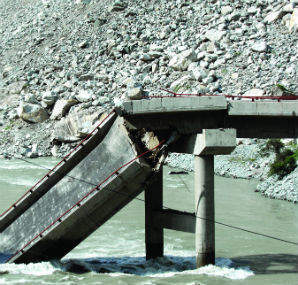New ICOLD Bulletins are now available from the Committee on Seismic Aspects of Dam Design.

ICOLD Bulletins 148 “Selecting seismic parameters for large dams” and 166 “Inspection of dams following earthquake ”, prepared by the Committee of Seismic Aspects of Dam Design of the International Commission on Large Dams (ICOLD) were published recently and can be obtained through www.icold-cigb.org.
Bulletin 148 is an important document, which provides modern seismic design criteria of the different structures and components of large storage dams:
- i. Dam body
- ii. Safety-critical elements such as low level outlets (bottom outlets) and spillways, which must remain functional that after a strong earthquake the reservoir level can be controlled or lowered to below the damaged zone and thus the safety increased
- iii. Appurtenant structures such as penstocks, pressure tunnels, powerhouse, power intake structures, switchyard, and non-safety-critical electro-mechanical and electro-mechanical equipment.
- iv. Temporary structures such as river diversion schemes, cofferdams, earth retaining structures etc. as well as critical construction stages.
For the seismic design and seismic safety checks of these four types of structures different types of design earthquakes are needed. For the dam body and safety-critical elements that include mainly gates and their motors and power supply, two levels of earthquakes are specified, i.e. the operating basis earthquake (OBE) and the safety evaluation earthquake (SEE). The ground motion parameters of these design earthquakes with return periods of 145 years for the OBE and 10,000 years for the SEE may be obtained from a probabilistic seismic hazard analysis. For the SEE ground motion parameters worst case earthquake scenarios may be considered in a deterministic analysis. For smaller dams, depending on the risk classification, shorter return periods are given for the SEE ground motion parameters. The comprehensive safety check of the components of safety-critical gate systems may be new as the y may have been designed for lower levels of earthquake motions, not taking into account their importance in the seismic safety of the project.
For the structures (iii) and (iv) the minimum requirements are those given in seismic building codes, if no more rigorous codes exist for these types of structures, which is the case in many countries.
Although the seismic design criteria are usually focussed on ground shaking only, Bulletin 148 is also addressing the other seismic hazards, which depending on the local conditions include, faults and/or discontinuities in the footprint of dams, which could be activated during strong earthquakes; mass movements at the dam site and into the reservoir, a hazard underestimated at many dam sites; liquefaction of dam and/or foundation materials, ground movements and others.
No specific design criteria are give explicitly for these hazards, but they have to be taken into account in the seismic design and safety assessment of dams.
Some of these hazards may be more critical than ground shaking.
The assumption that dams are generally safe against earthquakes often has not a sound engineering or scientific basis as. For example, during the 2008 Wenchuan earthquake in China, close to 2000 dams, reservoirs and powerhouses were damaged. The majority of the dams were small earth dams.
Earthquake inspection
Bulletin 166 is concerned with the earthquake inspection of dams. After a strong earthquake the condition and safety of dams subjected to strong ground shaking must be assessed. For example, after the 2011 Tohoku earthquake in Japan 2011, 400 dams had to be inspected within a short period of time. Therefore, a systematic approach is required for such inspections. Although large dams are inspected periodically, these inspections may not necessarily follow a fixed schedule.
In Bulletin 166 typical checklists are given for embankment and concrete dams and recommendations are made on the safety checks that have to be carried out depending on the intensity of ground shaking at a dam site. As in most countries strong earthquakes are rare events, the people in charge of dam safety and maintenance are not familiar with what has to be done after an earthquake, seismic safety checks should be carried out periodically.
It must be expected that Bulletin 148 will become an important document not only for the design of new dams, where the earthquake hazard is playing an increasingly important role, but also for the safety evaluation of existing dams, which have been designed against earthquakes – if designed at all -, using outdated seismic design criteria, in which the seismic hazard has been characterized by a seismic coefficient of typically 0.1, and where outdated methods of dynamic analyses, such as the pseudostatic method, have been used. Bulletin 148 provides the necessary information
Dr. Martin Wieland, Chairman, ICOLD Committee on Seismic Aspects of Dam Design, c/o Poyry Switzerland. Email: martin.wieland@poyry.ch
